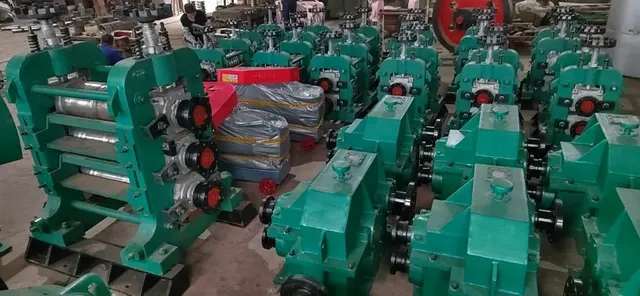How Rolling Mills Work in Steelmaking

A hot steel mill is a complex piece of equipment that uses heat and pressure to shape and refine steel. Here is a brief summary of how it works:
Preparation
Billet/Slab: The process begins with a billet or slab, which is a solid semi-finished steel that is usually cast from molten steel and solidified in a semi-finished shape.
Heating process
Heating furnace: The billet or slab is heated to high temperatures in the heating furnace. The goal is to get the steel to a forgeable temperature (usually between 1100-1300°C or 2000-2400°F) to facilitate subsequent rolling and forming.
Descaling
Descaling: During the heating process, a layer of iron oxide, called scale, forms on the surface of the steel. This scale is removed by methods such as high-pressure water jets or mechanical descaling devices to ensure a smooth rolling surface.
Rolling Process
Roughing Mill: The heated steel first passes through a series of large rollers in the roughing mill, which apply pressure to stretch and thin the steel into a more easily workable shape. The role of the roughing mill is to provide an initial reduction in thickness.
Finishing Mill: After roughing, the steel enters the finishing mill, which consists of a series of smaller, more precise rollers. These rollers further reduce the thickness and process the steel to the required specifications, ensuring the final size and surface quality.
Cooling Stage
Controlled Cooling: After rolling, the steel is usually cooled in a controlled manner, often using water spray or air. This process is called "running" or "cooling bed", and the cooling rate affects the mechanical properties of the steel, such as hardness and strength.
Coil Forming
Coil Forming: In many hot rolling processes, the finished steel is rolled into large coils, especially in hot rolled strip products. Coil formation facilitates the handling, storage and transportation of the steel.
Inspection and Testing
Quality Control: Throughout the process, a variety of quality control measures are implemented to check the steel's dimensions, surface quality, and mechanical properties. Testing may include testing for relevant properties such as tensile strength and hardness.
Subsequent Processing
Further Processing: Depending on the end use, hot rolled steel may undergo additional processing such as cold rolling, galvanizing, or other surface treatments to meet specific performance or appearance requirements.
Summary
In general, a hot steel mill works by heating the steel to make it ductile, then rolling it through different sets of rolls to achieve the desired shape and thickness, and finally cooling the finished product. This process is essential for producing a variety of steel products required by various industries such as construction and automobile manufacturing.
The working principle of a steel hot rolling mill involves a number of complex steps designed to process a billet into a finished steel product with specific shapes, dimensions and mechanical properties. The following are the main processes of hot rolling mill work:
Preparation Phase
Raw material preparation: The raw materials for hot rolling are usually steel billets. These steel billets need to be strictly inspected before hot rolling to ensure that there are no defects on the surface, such as oxide scale and rust.
Heat Treatment: The billet is fed into a reheating furnace and heated to high temperatures (usually over 1700°F), making it soft and ready for plastic deformation. This step is crucial for the subsequent rolling process, as it significantly reduces the energy required for rolling and improves product uniformity.
Rough rolling stage
Roughing Mill Processing: The heated billet enters the roughing mill, where heavy-duty rollers apply pressure to gradually reduce thickness and width. The main purpose of the rough rolling mill is to initially flatten and elongate the steel billet in preparation for the subsequent finishing rolling process.
Multiple Rolls: The billet is usually rolled multiple times in the roughing mill, with each rolling further changing its shape and size.
Finish rolling stage
Finishing Mill Processing: The rough rolled billet is then sent to the finishing mill for finer rolling. Finishing mills consist of multiple precisely aligned rollers that ensure the steel reaches the desired final thickness and shape.
Precise Control: During the finishing rolling process, the position and pressure of the rollers are precisely controlled to ensure the uniformity and consistency of the steel. In addition, the finishing mill can also adjust rolling parameters according to production needs to produce steel products with different specifications and properties.
Cooling Phase
Cooling treatment: After rolling is completed, the steel needs to be cooled to control its microstructure and mechanical properties. Cooling methods include natural cooling, water cooling or laminar cooling, etc. The specific method depends on the type of steel and production requirements.
Control the cooling rate: The cooling rate has an important impact on the performance of the steel, so the cooling process needs to be precisely controlled to ensure that the steel reaches the required performance standards.
Inspection and Finishing Phase
Quality Inspection: Cooled steel must undergo strict inspection to ensure compliance with production standards and customer requirements. The inspection content includes surface quality, dimensional accuracy and mechanical properties.
Finishing treatment: For steel materials that do not meet the requirements, necessary finishing treatment, such as straightening, shearing or surface treatment, etc., is required to meet the customer's final requirements for the product.
To sum up, the steel hot rolling mill converts steel billets into finished steel products with specific shapes, sizes and mechanical properties through a series of complex process steps. These steps include preparation, rough rolling, finishing, cooling, and inspection and finishing stages. Each stage is critical and requires precise control to ensure the quality and performance of the final product.